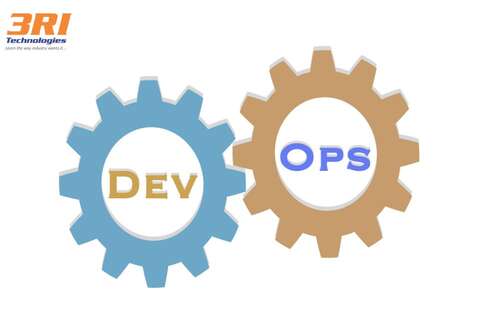DevOps brings together development and operations to make software development and delivery faster, more secure, and more efficient than traditional methods. A more agile software development lifecycle gives businesses and their customers a competitive advantage. Follow this blog to learn everything you need about DevOps, such as – what is DevOps in simple terms, what is DevOps mean, what is the need for DevOps, and so on.
What is DevOps?
DevOps is the collaboration between development and operations. It is a union of processes, people, and working products that allow integration and delivery of value to our end users in a continuous way. DevOps speeds up the process of getting applications and software services out to customers quickly and quickly. So that businesses can learn about the market and adopt it as soon as possible, reducing the risk because it keeps delivering and getting feedback from end-users and stakeholders from the beginning.
The close relationship between the words “Dev” and “Ops” defines each phase of the DevOps lifecycle, from the initial software analysis and planning to determine the codebase, building the application, end-to-end testing, and product release, and then to deployment, operations, and ongoing software monitoring. When two propels work together, they make a continuous customer feedback loop that makes it easy to keep improving, developing, testing, and deploying an application. The result of these efforts to improve can be the fast, continuous release of changes or new features that are needed based on how the business works and how well the client product does overall.
Interested to begin a career in DevOps? Enroll now for DevOps Training in Pune.

Get Free Career Counseling from Experts !
Now you know what is DevOps technology and let’s discuss its work process
How Does DevOps Work?
The DevOps model eliminates the need for two distinct departments: development and operations. To better prepare engineers for the wide variety of roles they may take one day fill; it is not uncommon for the development and testing teams to be merged with the operations and deployment teams.
Some DevOps models encourage increased collaboration between quality assurance and security teams and development and operations throughout an application’s lifecycle. The term “DevSecOps” describes the state of a DevOps team where security is a top priority for everyone involved.
These groups implement practices to automate activities that have traditionally been performed manually and take considerable time. They employ various tools and technologies to get their apps up and running quickly and reliably. To deploy code or set up infrastructure, for example, engineers can now do so without assistance from other teams thanks to the tools at their disposal. This makes a group even swifter than before.
Want to Upskill to get ahead in your career? Check out the DevOps Online Training.
What is DevOps Used For
DevOps allows Agile Development Teams to use Continuous Integration and Continuous Delivery, which speeds up the time it takes to get products to market.Let’s look at what is DevOps used for:
- For Predictability – Thanks to DevOps, new releases have a much lower failure rate.
- To Ensure Replicability – Everything should be versioned so that previous versions can always be retrieved.
- For Maintainability – Process for quickly recovering from a new release that crashes or disables the current system.
- For Dividing Larger Code Bases Into Smaller Chunks – DevOps utilizes the agile programming methodology. Therefore, it is possible to divide large codebases into smaller, more manageable pieces.
- Good Value For Money – IT management has always aimed for cost-effective software development, which DevOps offers.
- For Resiliency – The software system’s operational state is more secure, stable, and change-auditable.
- For Lower Risk – DevOps integrates security considerations into the software delivery lifecycle and aids in defect reduction.
- For Superior Quality – By incorporating infrastructure issues, DevOps aids the team in enhancing the quality of application development.
- Time To Market – By streamlining software delivery, DevOps can reduce time-to-market by up to 50 %. This is especially true for mobile and digital applications.
Update your skills with DevOps With AWS Training

Meet the industry person, to clear your doubts !
What is DevOps Lifecycle
The DevOps lifecycle includes several phases. Let’s go over each phase of the DevOps life cycle.
- Continuous Development
The software is “planned” and “coded” during this phase. The project’s vision is selected during the planning phase, and the developers then write the application’s code. While many DevOps tools are available for code maintenance, they are not required for planning.
The code can be written in any language, but it must be maintained using version control tools. The process of keeping the code current is known as source code management. Git is the most used program, followed by SVN, Mercurial, CVS, and JIRA. Tools like Ant, Maven, and Gradle can build/package the code during this phase to send it to any following degree as an executable file.
Let’s try to learn more about Git now.
- Git is a tool for keeping track of different versions of software. It supports distributed workflows that don’t go in a straight line by making sure that data is correct. Tools like Git make it possible for the development and operations teams to talk to each other.
- When making changes to a big project that a lot of people are working on together, it’s very important for the people working on the project to talk to each other.
- Git’s commit messages are a very important way for the team to talk to each other. Aside from communication, the primary benefit of using Git is the constant availability of a stable code version.
- So, Git is a very important part of being successful in DevOps.
2. Continuous Testing
The developed software is currently being continuously tested for bugs. Continuous testing uses automation tools like Selenium, TestNG, JUnit, etc. With the help of these tools, QAs can restrict the functionality of several code bases at once to ensure there are no bugs. Docker Containers can be used in this phase to simulate the test environment.
TestNG is used to create reports, and Selenium is used for automated testing. The entire testing phase can be carried out automatically with a program called Jenkins for Continuous Integration. You created a Java selenium code to test your application. Now, you can make this code using ant or maven. After the code is written, user acceptance testing is carried out (UAT). The entire procedure can be automated using Jenkins.
In comparison to performing the tests manually, automation testing saves time, effort, and work. The ability to create reports is a major plus. Examining a test suite’s failed test cases becomes simpler. The test cases can also be run at predetermined times. The code is added to it after it has been tested.

3. Continuous Integration
The DevOps life cycle’s most crucial phase is this one. Developers must make changes to the source code more frequently and then commit them to this method of creating software. This might take place each day or each week. Every commit is then built, making it possible to identify any issues as soon as they arise. Compiling, code review, unit testing, integration testing, and packaging are all steps in writing code.
The existing code is constantly being updated with new features. The updated code must be continuously and smoothly added to the systems because the software continually improves, allowing users to see the changes.
During this stage, Jenkins is a tool that is frequently used. Jenkins pulls the updated code from the Git repository and converts it into a jar or war file that can be executed. Every time the Git repository is changed, this takes place. The server where it will be used or the test server will then receive this build.
4. Continuous Deployment
The production servers are now where the code is deployed. Making sure the code is correctly deployed on all servers is also crucial. Before moving on, let’s first get a fundamental understanding of configuration management and containerization tools. Continuous Deployment is facilitated by this set of tools (CD).
Establishing and preserving uniformity in an application’s functional requirements and performance is known as configuration management. It schedules updates on all servers, releases deployments to the servers, and ensures that all servers have the same configuration.
Tools for configuration management are essential to the quick and frequent execution of tasks because new code is constantly deployed. Popular tools like Puppet, Chef, SaltStack, and Ansible are used here.
Containerization tools are used to maintain the application’s development, testing, and deployment environments. These tools eliminate the possibility of errors or failures in the production environment by packaging and replicating the same dependencies and packages used in the development, testing, and staging environments. It makes running your application on different computers simple.

Do you want to book a FREE Demo Session?
5. Continuous Monitoring
In this crucial stage of the DevOps life cycle, you continuously monitor the performance of your application. Here, essential data on software usage is documented. To determine the proper functionality of the application, this data is processed. System errors like low memory and unavailable servers are fixed during this phase.
The root cause of any issue is found during this phase. It guarantees the services’ accessibility and safety. During this stage, network problems are also fixed. It enables us to resolve issues as soon as they are found automatically.
The Operations team must participate in this process because they will watch user activity for bugs and errant system behavior. Splunk, ELK Stack, Nagios, NewRelic, and Sensu are well-liked tools. With these tools, you can perform proactive system health checks while closely monitoring the performance of the servers and applications.
DevOps phases are continuously cycled through until the desired product quality is reached. Consequently, DevOps has become the standard for product development at most of the biggest IT companies.
Stand out with DevOps Foundation Certification
Final Words
DevOps is a method that is becoming more and more popular. Its goal is to bring together developers and operators into a single unit. It is different from traditional IT operations in a unique way and works with agile, but it is not the same as elegant. I hope you know what is DevOps and how it works, what is DevOps definition, etc; check out this DevOps Training Course provided by 3RI Technologies, a reputable online learning company with a global network of thousands of satisfied students.
